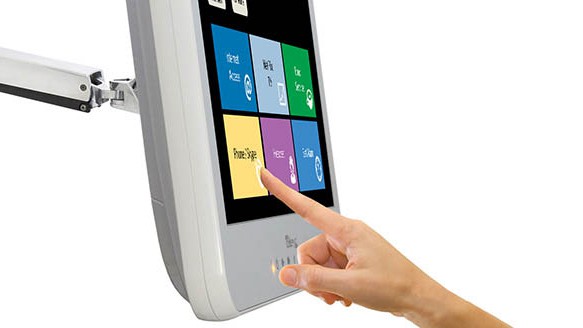Moore’s Law states that the number of transistors on a microchip doubles every two years. This law, when realized in practice, translates into a) ever-more powerful and sophisticated chips, and b) proportionally cheaper technologies relying on them.
Further amplifying this concept, Kurzweil’s Law of Accelerating Returns states that technological advances grow exponentially, rather than linearly. Moreover, the pace of exponential growth is growing exponentially, and within the foreseeable future, Artificial Intelligence will surpass human, with The Singularity being an inevitable consequence.
Bedside Computer Charting – A Look Back
Article Guide
Bedside computer charting systems display both of those laws in action. In 1992, Point-of-Care (POC) systems were at the early stages of adoption – only 3% of American hospitals with 100+ beds deployed bedside charting using computers. An article Bedside Computer Charting: Inching Toward Tomorrow, Charles Myers names the greatest roadblocks to the adoption of bedside charting back then:
- the high cost of systems back then ($2,000 to $30,000 per bed)
- high risk – hospitals did not want to gamble on costly technology without a proven track record of quantifiable benefits
- poor integration with other systems, such as laboratory and pharmacy, and lack of interfacing flexibility
However, early adopters and industry visionaries could see where the bedside charting systems would be by now due to their benefits. Convenient access to patient’s health records, improved nursing productivity and accuracy of data, legibility, reduced paperwork and duplicate entries, simultaneous access to the same and crucial information from different locations by different specialists, reduced documentation and overtime are just the tip of the improvements bedside charting yielded to hospitals a little less than three decades ago, according to Meyers.
The Challenges of Today
What has changed since then is that now innovative solutions aim not only to improve nursing productivity but alleviate nurse burnout due to technological and notification fatigue. More with less is the current and the future trend for the health IT industry. The present is also the continuous pursuit of interoperability, reduced time spent on EHR, data intelligence and patient-centric approach to care.
A bedside monitor in any Intensive Care Unit routinely provides a wealth of data – vital signs and waveforms. The bedside monitor captures hundreds of data points per second, but nursing staff normally chart on a per hour basis. Changes are traced over several hours. Experts call it a “remarkable waste,” urging the industry to harness the valuable information hidden within that “skipped” data.
AI and Internet-of-Things are the technologies developers rely on to address the issue. Big Data and its analysis calls for superior processing power, so bedside charting systems need to have enough capacity and resources to accommodate the incoming solutions. The innovation of today becomes the norm tomorrow, so it makes sense to future-proof the POC investment with the capacity you will need soon.
Interoperability was the focal point of this year’s HIMSS conference. The need to allow the disparate systems, equipment, specialists, departments and institutions to be interoperable and harness the smooth data exchange is glaring now. As hospitals and manufacturers have spent decades developing isolated systems, with proprietary terminology and interfaces, the present HIT systems are riddled with interoperability issues.
Bedside charting systems appeared because the industry needed a solution to cut the documentation time. Nurses had to cut that time from the direct interactions with patients, and POC provided excellent results. Charles Myers cites significant productivity improvement due to the introduction of bedside charting systems. Besides overtime savings of half an hour per nurse per shift, bedside charting helped hospitals attract and retain nurses. The nursing staff would spend twice as much time in the patients’ room.
However, with the advent of EHR, the sector faced the so-called IT productivity paradox. As of now, EHR documentation – now in electronic form – takes medical staff 2-3 hours of uncompensated time daily, after work. At some point, regulations mandating EHR adoption, and ACA changing hospital reimbursement system collided with technology and people.
Therefore, bedside charting systems have now evolved to accommodate EHR and patient infotainment systems. Bedside computers running EHR enable nurses and physicians complete the documentation at the point of care and spend less time after work on “paperwork.” By incorporating patient infotainment systems into the bedside computers, hospitals cut the IT costs and increase patient satisfaction rates.
The latter is a part of the patient-centric approach the industry requires. “The patient is not just at the center of care but is part of the care team, and is considered an actor of care,” as the Health Innovation Report cites Vincent Dumez, Faculty of Medicine, Université de Montréal. Infotainment systems play a significant role in improving doctor-patient-nurse interaction, communication, and help increase patient awareness and control.
Recommendations
While HIT cannot solve all the problems in health care, there is evidence it does improve:
- clinicians’ decision-making
- decreasing healthcare costs
- helping nurses to obtain critical patient information rapidly while delivering care
- with mobile technology added, health IT help improve communication, reduce errors, improve patient safety
Both Meyer in 1992 and Toofany in 2016 stress that the successful implementation of clinical IT systems depends on user acceptance.
- Even excellent IT systems cannot deliver the results expected of them if the staff does not support their use.
- One of the biggest mistakes a healthcare institution can make is not to involve the “representative staff,” and nurse involvement is crucial.
The nursing staff involvement helps organizations choose the most relevant solutions that:
- can be customized before acquisition and configured by the users after acquisition to tailor the hardware, software, and peripherals
- are compatible with legacy systems and can interface with them
- provide electrical and radiation safety for near-patient use
- provide data security and advanced authentication mechanisms that are easy-to-use
- have superior computing power in an ergonomic form factor
- provide usability without compromising other features
- have antimicrobial* properties that protect the computer casing from deterioration and degradation
- protect the data integrity from the loss in the event of a power outage
- are easy to use overall, without a steep learning curve
The Future
Deloitte stresses the exponential technological progress, providing HIT manufacturers guidance on where the industry’s future is headed:
- more computing power in an increasingly smaller form factor
- more data storage capacity and network connectivity options
- more software capability
- increasing reliance on mobile and sensor technologies, AI and data analytics
Deloitte outlines the shifts in health care landscape:
- from acute to preventive care, from specialists to self-care, from hospital to home care
- from monitoring single biometric indicators to multiple, processed by AI
- from intuitive approach based on empirical evidence to precision-based care harnessing the data provided by health IT systems
- from silo-ed medical knowledge to centralized, accessible knowledge centers
There is great potential for healthcare organizations and HIT developers to capitalize on those shifts. Those that keep ignoring them may lose revenue and market share if they fail to offer “consumer-centric products and end-to-end solutions.”
Modern medical grade computers used in bedside charting enable all these shifts, future-proofing your systems for further upgrades and expansions to accommodate more functionality. These systems are used by both medical staff and patients, improving outcomes and patient satisfaction rates. Contact Cybernet today to learn more about our solutions for healthcare!
Patient Infotainment – The Benefits of Utilizing Bedside Computers
February 25, 2016
We as a thinking species have evolved in more complex ways than one. In terms of our understanding and accepted definitions of technology, for instance. In the new globalized lives we lead today, ‘medicine’ has evolved…
0 Comments4 Minutes
The Essentials of a POS Computer System
February 17, 2015
Point-of-Sale, or simply put, POS is the physical place where a retail transaction reaches its completion. This is also the point where a customer actually makes the payment in exchange for goods procured or services…
0 Comments5 Minutes
You Can't
Learn from a Pop-up
But we can deliver knowledge to your inbox!
We dive deep in the industry looking for new trends, technology, news, and updates. We're happy to share them with you.
Knowledge, News, and Industry Updates Right in Your Inbox




